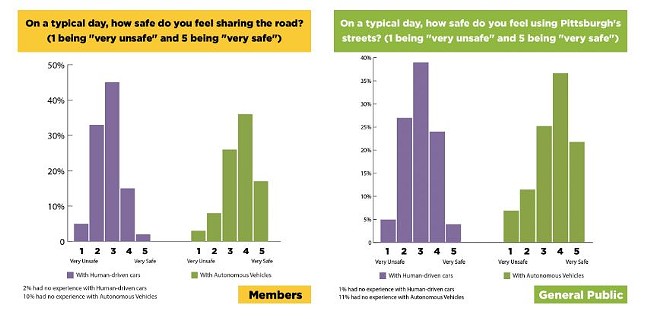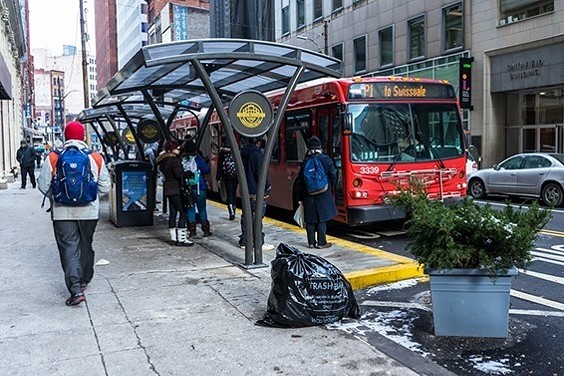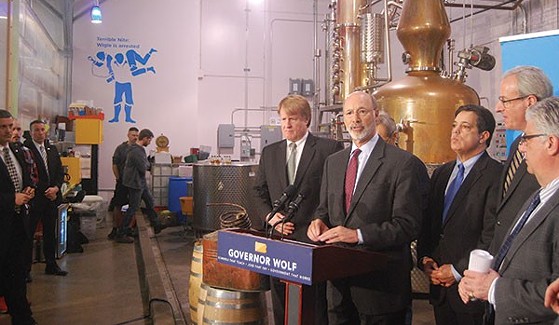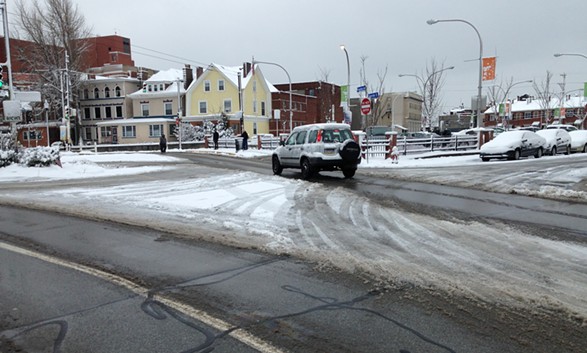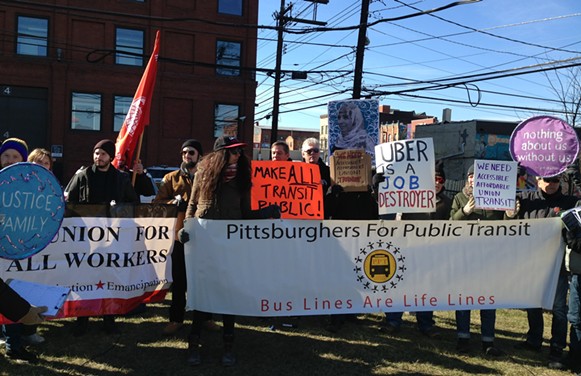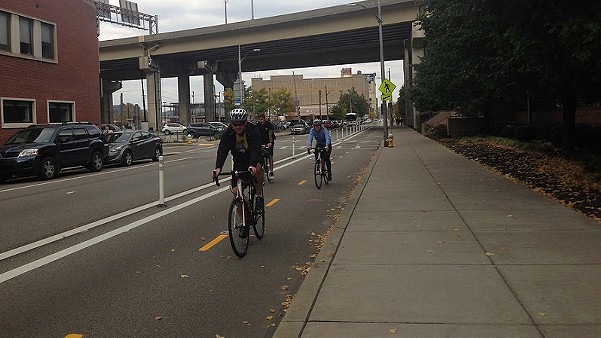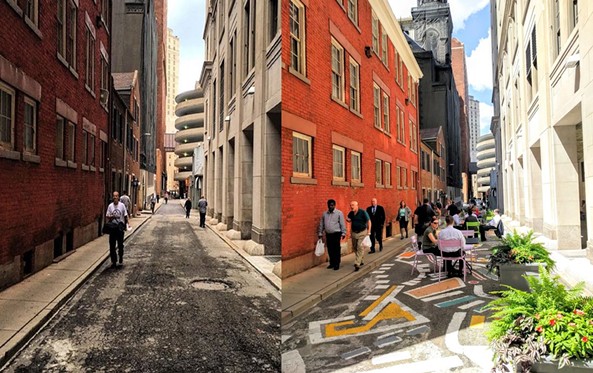Wednesday, May 17, 2017
Tags: Bike Pittsburgh , National Bike to Work Day , Image
Friday, April 21, 2017
Pittsburgh City Councilor Darlene Harris (D-North Side) is running for mayor, but her campaign hasn’t produced many detailed plans on how she plans to improve the city. Instead, she’s provided a critical, almost-laser-like focus on one issue: bike lanes.
Harris recently rated Pittsburgh Mayor Bill Peduto’s mayorship as a “D-minus,” telling WTAE on April 18 because Peduto “put all these bike lanes in.” And, for her closing statement of an April 19 mayoral debate, she said, even though bike lanes weren’t brought up during the debate, “We did not talk about bike lanes at all this evening, and I wonder why? We have nothing with bike lanes, no safety attached to it, no studies, nothing. And someone is going to get seriously hurt. … Public safety is very important to me.”
Tags: Darlene Harris , Pittsburgh City Council , Bike Pittsburgh , PolitiCrap , Image , Video
Wednesday, March 29, 2017
On March 24, Pittsburgh mayoral candidate John Welch issued a new campaign ad claiming that Mayor Bill Peduto had “misplaced priorities.” Welch said in a Facebook post adjoining the ad that Peduto is “putting bike lanes over the health of city residents.”
“Now I like bike lanes, but not that many people use them, but we all rely on clean and safe drinking water,” said Welch in the ad. “So for me it is a matter of priorities, and we can see now that his priorities are not our priorities.”
The bike advocates at Bike Pittsburgh take issue with Welch’s assertion. Scott Bricker, director at Bike Pittsburgh, wrote in an email to Pittsburgh City Paper that bike lanes serve a public-health need, as they provide safe passage for city cyclists and encourage people to ride and stay fit.
“Both funding for bike infrastructure and funding for clean drinking water are expenditures to keep Pittsburghers healthy and safe,” wrote Bricker. “Pitting one against the other is bad policy. Using the City's bike infrastructure budget isn't a real solution to the lead problem and Mr. Welch knows it.”
In fact, at a March 28 press conference, Allegheny County Controller Chelsa Wagner estimated the cost of replacing all the lead-service lines in the city could be around $25 million. And according to capital budget figures since Peduto came into office in 2014, his office has allocated — but not spent all of — about $216,000 a year in city bonds and funds towards bike-related projects. According to Bike Pittsburgh’s calculations, it would take 125 years to solve the city’s lead-water-pipe problems using bike funds at the level they are typically spent.
(Side note: Local news sources tend to write stories about how the city is allocating millions of dollars in funds for bike lanes. But according to the city's past four capital budgets, often not all of that money is spent because the projects never materialize; the funds are then carried over to the next year. Also, many news stories fail to mention that the bulk of bike-land funding in Pittsburgh consists of state and federal grants awarded to the city.)
Bricker wrote that Bike Pittsburgh also believes the city should tackle its lead problems, but said it’s not fair to pin those problems on bike-infrastructure funding.
“We’ve known lead has been a problem for human health for generations,” wrote Bricker. “But people should know that you just can’t solve this lead problem by taking away money for safe streets. There’s nowhere near enough money. What little money does exist for bike lanes is used to leverage state and federal transportation dollars which cannot be used to replace lead service lines.”
In a blog posted on Welch’s campaign website, Welch wrote, “As mayor of the city of Pittsburgh, I would work hard to ensure that the public health of the residents of our city rises to the highest priority possible. We deserve better as we strive to be a city where all can flourish.”
However, Welch hasn’t shared publicly what his specific plans would be to address the lead issue. At a March 22 press conference, when asked by reporters about his plan for restructuring PWSA to mitigate the lead issue and other problems, Welch told reporters to ask him again on May 17, the day after the upcoming primary election.
Bricker wrote that he feels Welch is using bike lanes as a “wedge issue” to take advantage of Pittsburgh voters who don’t fully understand the reasoning behind bike lanes. Bricker cites Downtown's Penn Avenue lane as a success story. The lane sometimes hosts more than 1,000 trips per day, and Bricker says about one quarter of morning traffic on the street is bike traffic. He also wrote the redesign of Penn Avenue Downtown has helped eliminate bottlenecks at the 16th Street Bridge and at 11th and 9th streets.
“He knows what he's doing,” wrote Bricker of Welch. “He's trying to score political points.”
Bricker asserted that Bike Pittsburgh doesn't endorse political candidates, but the group does encourage its members to vote. This year, Bike Pittsburgh is continuing its mayoral-petition program called “I Bike. I Walk. I Vote,” which asks people to sign petitions calling on candidates to pledge to make commitments to bike- and pedestrian-friendly policies. Bricker wrote that in 2013, Bike Pittsburgh garnered 3,000 signatures, with 80 percent of respondents being registered voters. Bricker noted that Peduto won election that year by only about 5,000 votes.
Of people who signed the petition, Bricker wrote, “They're educated and very civically engaged."
Update: Welch responded a day after the article was published with an email to CP writing "I specifically stated that I had no problem with bike lanes and even said as much in a private conversation with Scott Bricker. I want to set the record straight. I congratulate [Bike Pittsbugh] for standing up for bicyclists but who is standing up for city residents who rely on PWSA for safe drinking water?"
Welch then goes on in the email to accuse Bike Pittsburgh of selfishness writing "how dare [Bike Pittsburgh] make this issue about themselves?" and claiming that Bricker was defending Peduto because Bricker is a mayoral-appointee to the Southwestern Pennsylvania Commission (a transportation and development-planning agency). Welch went on to write that his ad and words are less about bike lanes and more about drawing "attention to the poisoning of our children, and contrast the swiftness to which this mayor responded to the need for dedicated bike lanes with his inaction on a public health crisis."
Bricker says he stands by what he said originally citing again that Bike Pittsburgh does not endorse political candidates. "[Welch] is calling out our private conversation, but publicly he is dissing the work that we do," says Bricker, defending the advocacy that Bike Pittsburgh does to try and get more bike-friendly infrastructure in the city. "We can hold two opinions at the same time, we also don't want our children's water poisoned."
He also defends his position as an appointee on the SPC. "I am not beholden to the mayor," says Bricker. "I am confused by his statement. It's a service I am willing to do, because of my expertise. I don’t receive any money. Sometimes I receive headaches." (Welch also pointed out in his statement that he is also a mayoral appointee, Sports and Exhibition Authority, but wrote in his statement that "I don't need to score political points, only [to] be bold enough to challenge the mayor.")
Bricker also questions why Welch is attacking a local advocacy a group that has has a long-standing presence in Pittsburgh and thousands of members. "I don't want to trade barbs in the media," says Bricker. "We have never been in this position before where people are trying to pit our issue against other city issues."
CP News Editor Rebecca Addison contributed to this blog.
Tags: John Welch , Bike Pittsburgh , Bill Peduto , Scott Bricker , bike lanes , PolitiCrap , Image , Video
Wednesday, March 22, 2017
Because of this unpredictability, it's not all that surprising that Pittsburgh cyclists would support taking the human element out of driving, and data recently released by Bike Pittsburgh proves it. The bike- and pedestrian-advocacy organization released a survey on March 21, showing that only about 10 percent of Bike Pittsburgh members with and without experience sharing the road with driverless cars disapprove of Pittsburgh as a testing-ground for autonomous vehicles. Moreover, about 75 percent of Bike Pittsburgh members actually approve or somewhat approve of driverless-car testing in Pittsburgh. (Somewhat ironically, a recent survey of Americans with AAA coverage showed that 75 percent of drivers were afraid of fully autonomous vehicles.)
In September 2016, Uber debuted its semi-autonomous vehicles in a highly publicized event. Since then, semi-autonomous Volvo SUVs and Ford sedans have been navigating select Pittsburgh neighborhoods, with a driver ready to take over and a technician monitoring the driverless components.
The survey compiled responses from 321 Bike Pittsburgh members and about 800 non-members. About 40 percent of members said they have interacted with a driverless car either on bike or on foot (non-members have interacted with AVs slightly less on bike, but slightly more on foot).
“While our own personal experiences riding and walking alongside AVs have been mostly positive, we believe that the introduction of these vehicles to our streets deserves a larger conversation,” said Eric Boerer, BikePGH Advocacy Director, in a press release. “As far as we know, we are the first organization collecting these stories from bicyclists and pedestrians.”
Both members and non-members also said they felt safer when interacting with an autonomous vehicle, rather than with a car controlled by a driver, even if there were still some uneasiness. "People noted the lack of road rage and aggression toward them as opposed to human drivers," said the study. "However, many were not comfortable with the dehumanization of the interaction even if it ended up being safe."
But not all reports were positive, according to the press release. While most bike-riding respondents noted driverless cars gave four feet while passing, several people cited times AVs passed them only giving a few inches. Additionally, some walking survey respondents noted driverless cars didn't stop for them while waiting to cross the street, and one respondent witnessed an AV running a red light. (It should be noted that Recode recently published a story showing that while Pittsburgh has become the epicenter of semi-autonomous vehicle testing in the U.S., the driverless cars only travel an average of 0.8 miles before human drivers have to intervene.)
Regardless, respondents of the survey want Bike Pittsburgh to support AVs; 50 percent of members and 43 percent of non-members want the bike-advocacy organization to "actively support" autonomous vehicles. Only 3 percent of members and 7 percent of non-members want them to oppose AVs.
Tags: Bike Pittsburgh , Uber , Pittsburgh , Image
Wednesday, March 8, 2017
Port Authority of Allegheny County leadership quietly shaken up, advocates ask for more transparency
At the time, Port Authority board chair Bob Hurley wouldn’t elaborate on the decision to cut ties with McLean, only saying that the decision between the board and the CEO was “mutual.”
"This transit agency has come so far from where we were just a few short years ago, which is why I believe now is the right time for me to pass the torch to someone else," McLean said in a statement issued after the Feb. 24 meeting.
On March 3, a TribLive article stated that Hurley will likely leave the Port Authority board and his seat will be replaced by Allegheny County Executive Rich Fitzgerald’s chief of staff Jennifer Liptak. Port Authority vice chair Jeffrey Letwin will likely step into the chair role. Allegheny County’s initial announcement of this shift came on March 3 and was at the end of a statement containing a laundry list of legislation that Fitzgerald had introduced to Allegheny County Council; there was no mention of Hurley departing the Port Authority Board.
On March 7, Fitzgerald nominated Hurley to serve on the county’s Airport Authority board. Fitzgerald says he wanted to see Hurley, who is also head of the county’s economic development team, on the Airport Authority because the county owns thousands of acres of developable land surrounding the airport. “The plan was always to move [Hurley] to the airport,” says Fitzgerald. “There is so much economic development opportunity there.”
However, Fitzgerald provided no comment on why Liptak would be joining the Port Authority board in the March 3 TribLive article, but told City Paper earlier today that he is confident in Liptak because “she does a good job wherever she is.”
Liptak, who Fitzgerald says will be leading the search for the new Port Authority CEO, has served in county government for years and offers a breadth of experience in budgeting and development, but with little official public-transit experience. But Fitzgerald says Liptak has been “involved in every transit decisions we make,” and she has “good relationships with all the stakeholders that deal with transit in the region.”
All of these big shifts with little public notice has made some advocates wary of the board-appointee process. Molly Nichols, of the public-transit-advocacy group Pittsburghers for Public Transportation, wonders why these big decisions happened so quickly and relatively quietly. She is calling for more transparency when board members are appointed.
“PPT would like to see more transparent processes for board appointments, including naming the qualifications of appointees and holding public hearings,” says Nichols. “This would give the public the opportunity to ask appointees how they plan to serve the transit riders of Allegheny County.”
This isn't the first time that Fitzgerald's handling of board appointments has come under fire. Although he has since abandoned the policy, after taking office in 2013, he required all board members to submit undated letters of resignation that Fitzgerald could activate at any time. There was also some tumult when Fitzgerald ousted PAT's former director and put his own appointees in power positions, also in 2013
Fitzgerald’s Port Authority appointees, like Liptak, don’t require any confirmation by county council or any public vetting. Hurley’s appointment does need approval by county council, but out of hundreds of Fitzgerald’s appointees, council has only failed to confirm one, a man indicted on federal embezzlement charges in 2010.
But Fitzgerald says the timing of Port Authority CEO leaving and Hurley moving boards shouldn’t be taken as upheaval at the Port Authority. He says the reason these changes were made quickly is because the authority is stable. “It is not like we have all these problems we have to make changes, it’s just the opposite,” says Fitzgerald.
In terms of increasing public participation in the appointee process, Fitzgerald believes the current system works fine as is.
“We get a lot of folks who suggest board members,” says Fitzgerald. “At the end of the day, the elected officials are given the responsibility that these agencies run well. If it doesn't run right, we are going to be the ones taking responsibility.”
This sentiment somewhat echoes a statement made by Steve Palonis, of Amalgamated Transit Union Local 85, after the announcement of McLean’s departure. Palonis said in the Post-Gazette, “Rich [Fitzgerald] is the guy in charge and this is what he wants to do.”
Tags: Rich Fitzgerald , Port Authority of Allegheny County , Bob Hurley , Jennifer Liptak , Allegheny County Council , Image
Wednesday, February 15, 2017
For the past several years, a growing chunk of the Pennsylvania's motor vehicle fund has been siphoned off to pay for an increasing number of Pennsylvania State Police troopers. (Monies from the fund are used to pay for a multitude of projects, including bridge and road construction.) Last year, state legislators responded by passing a rule limiting PennDOT’s allocation for state police, and mandated that allocation shrink by 4 percent each year until it’s reduced to $500 million. But Gov. Wolf is going even further and is proposing moving the state-police funding out of the motor vehicle fund entirely.
In his 2017-2018 budget, Wolf wants to fund the troopers through a $25-per-person fee, for towns that rely solely on the service of state police, instead of taking money from the motor vehicle fund. "Nothing else in life is free," said Wolf of state police in Allentown’s Morning Call in February, "and this isn't either."
Chris Sandvig, a transit expert at Pittsburgh Community Redevelopment Group, says that under the current circumstances, the motor vehicle fund is obligated to pay for both road construction projects and state police, meaning funding for state police is in direct conflict for money that could go to improve our roads. Sandvig says that as the motor vehicle fund is increasingly taken over to pay for state police, then money to build road constructions could then be in conflict with funds for public-transit improvements.
And Sandvig says more and more small municipalities are using state troopers to police their towns. In fact, statewide news website Keystone Crossroads reported in May 2016 that more than half of Pennsylvania municipalities fully rely on state troopers for police service.
“The users of the highway system are paying for state troopers in towns that don’t want to pay for police,” says Sandvig.
Sandvig says the more money used from the motor vehicle fund to pay for state police means a significant chunk is unavailable to pay for potential public-transit projects. In 2010, the motor vehicle fund contributed $530 million to state police, and in 2016 it had ballooned to $839 million. “If it continues at this rate, it’s on track to a hit a billion dollars this year,” says Sandvig. “This is unsustainable, and something needs to be done.”
Currently, the motor vehicle fund is primarily funded from a tax on gasoline and a fee collected through motor-vehicle registration. Sandvig is pleased with the governor’s proposal. “So many people put so much work into funding public transportation, and the money we pay at the pump should go to transportation," says Sandvig.
Wolf’s proposal needs support from the state legislature before becoming law, but state Republicans, who control both the House and Senate are open to negotiating a fee on municipalities.
Tags: Governor Tom Wolf , Pittsburgh Community Redevelopment Group , Pennsylvania State Police , Image
Thursday, February 9, 2017
After snowfalls, Pittsburghers can see sneckdowns just about everywhere they look, since there are plenty of places where snow falls on the street that cars don’t drive over. Sometimes these untouched snow patches are as small as a kite, but other times they are as large as an above-ground swimming pool.
Eric Boerer, of Bike Pittsburgh, says they illustrate exactly how much extra space is given to vehicles on Pittsburgh streets.
“The clear thing is that they show a lot of unused road space,” says Boerer. “And this is one of the big issues we have in such a tight city.”
Boerer says some of the most egregious sneckdowns occur in Bloomfield. He points to the intersection of Liberty Avenue and the Bloomfield Bridge, and spaces around Friendship Park, as an areas where snow highlights a lot of unused square footage. He believes this unused space provides strong arguments that sidewalks can be made larger and bike paths can be installed, even if the city has a sometime contentious relationship with winter bike riders.
Bike Pittsburgh does a lot of outreach to teach Pittsburgh residents about smart road design that can accommodate cars, bicycles and pedestrians equally. (This concept is known as complete streets.) Boerer says normally groups like Bike Pittsburgh would have to set up physical objects and staff in sections of roads to prove roads can be designed differently, but sneckdowns accomplish that work for them.
“It is almost like a real-time [road design] experiment,” says Boerer. “It proves your point without doing an intervention. It can reveal a lot about how motorists are using the streets.”
Sneckdowns can also reveal other uses for wasted space on road. Boerer says sneckdowns at the intersection on Schenley Drive (near the Schenley Park visitor center) reveal ample space that could be used for green space, like grass or bushes. He says this could help mitigate stormwater issues that occur often in Oakland and Four Mile Run in Greenfield.
Boerer says sneckdowns are well known in the bike-ped advocacy community and by city planners, but there have been no street redesigns in Pittsburgh as a result of sneckdowns as in New York City and Philadelphia. But, he is hopeful that will change considering Pittsburgh’s growing interest in road design with the city’s formation of the Complete Streets Advisory Council.
“Right now there is a lot of momentum on complete streets,” Boerer says. “Sneckdowns are part of that. [They are] a great way to visualize these traffic calming ideas.”
Tags: Bike Pittsburgh , Complete Streets , Sneckdown , Image
Monday, February 6, 2017
But protesters in Pittsburgh are still upset with the ride-hailing company. On Feb. 4, a group of more than 35 protested at Denny Park in the Strip District, and then marched toward Uber’s Advanced Technologies Center (where they make and test driverless cars), located just a few blocks away.
Laura Wiens, of transit-advocacy group Pittsburghers for Public Transportation, commended Kalanick for stepping down from Trump’s advisory council, but believes the company can do more to support immigrants. Wiens said she would also like to see Uber oppose state anti-immigrant bills like SB 10, Pennsylvania’s anti-sanctuary city bill currently in the state Senate.
Uber spokesperson Craig Ewer responded to the protest with a statement sent to City Paper: "More than ever, it's important that we all support freedom of speech. Like many others, Uber strongly opposes the President's unjust immigration ban which is harming many innocent people, many of whom are drivers. That's why we created a $3 million legal-defense fund to help, and why we're offering compensation for lost earnings for any driver stranded abroad. We will continue to stand up for those being hurt by the President's executive order."
Uber also recently donated $10,000 to Women's Center and Shelter of Greater Pittsburgh to provide rides to victims of domestic abuse.
Wiens added that the group's frustration with Uber goes beyond its immigration-related policies, and PPT believes Uber has policies that hurt workers.
“Just as Trump is in support of deregulation, so is Uber,” said Wiens. “Just as Trump is anti-worker, so is Uber.”
Sean McGrath is an Uber driver who said Uber has labor practices that hurt drivers’ ability to make money and speak out against management. Uber refers to drivers as “partners” and pays drivers as independent contractors, not employees.
“The partnership is only one-way,” said McGrath. “There is no way for us to voice our opposition.” McGrath has recently grown frustrated with how quickly the Uber app updates its “hot spots,” or highlighted areas where drivers can take advantage of surge-pricing rides. “This zones refresh every 15 seconds, so you expect to get a good pay, but then the surge disappears by the time you arrive.”
Tom Conroy, of the Amalgamated Transit Union, which represents most of the county’s public-transit workers, was most critical of Uber’s specific role in Pittsburgh: driverless vehicles. He says driverless vehicles could eliminate public-transportation jobs and that Uber has been silent on this topic.
“Where is [Uber’s] commitment to the 100,000 of workers who stand to lose jobs with the emergence of autonomous cars,” said Conroy. Protesters also called on Uber to share its transportation data with Pittsburgh, as well commit to a more transparent process when working with the city and community.
Tags: Uber , Pittsburghers for Public Transit , Donald Trump , Image
Friday, January 6, 2017
Now, two years after having set up protected bike lanes Downtown on Penn Avenue (which sometimes receives more than 1,000 trips per day) and the Roberto Clemente Bridge, the city is still facing strong push-back on an extension to that system along Fort Pitt Boulevard. In response, Pittsburgh City Councilor Theresa Kail-Smith (District 2) is proposing the creation of a bike-lane committee to field complaints and suggestions for new bike lanes.
However, as advocacy group Bike Pittsburgh points out, there already is a Complete Streets Advisory Committee being set up that can field road-design complaints, such as for bike lanes.
“We believe that [Pittsburgh] should first concentrate on getting the Complete Streets Advisory Committee off the ground and running — a committee that was written into the Complete Streets bill that unanimously passed council in November,” wrote Bike Pittsburgh director Scott Bricker in an email to City Paper. “If a bicycle-only advisory committee is still needed, so be it, but they should figure out how it will coordinate with the Complete Streets Committee so that the two are not redundant.”
In addition to the Complete Streets committee, Pittsburgh’s Department of City Planning conducts numerous public meetings every year led by bike/pedestrian coordinator Kristine Saunders, where complaints and suggestions about new bike-lane projects can be filed. CP has sat in on many of these meetings, which are always held in the neighborhood directly affected, and they usually include many representatives from both the pro-bike-lane and anti-bike-lane creed.
Nonetheless, the Pittsburgh Trib Live reported Jan. 3 that Kail-Smith was motivated to set up a bike-lane committee due to “numerous complaints about existing lanes Downtown from residents who say they take up space for street parking and cause traffic congestion.”
But the assertion that bike lanes cause more congestion actually runs contrary to studies in multiple big cities across the country. In New York City, a protected bike lane on Columbus Avenue actually improved congestion, decreasing travel time for cars from 4.5 minutes to 3 minutes along a 20-block stretch. In Minneapolis, the U.S.’s top bike-commuting city, news-data website fivethirtyeight.com studied 10 segments in the Minnesota city in 2014 and determined that the addition of a bike lane at the cost of a car lane had no affect on traffic times for cars.
In fact, a 2013 University of Virginia study shows that bike riders only reduce congestion when they have bike lanes to ride in. The Fort Pitt Boulevard proposed extension to Downtown's protected bike lane would add about half-a-mile of lanes and connect directly to the Great Allegheny Passage trail, which runs to Washington, D.C.
The proposed bike-lane advisory committee will be discussed at 10 a.m. Wed., Jan 11, in the city council chambers, located on the fifth floor of the City-County Building at 414 Grant St., Downtown.
Tags: Theresa Kail-Smith , Bike Pittsburgh , Penn Avenue protected bike lane , Pittsburgh City Council , Image
Thursday, January 5, 2017
Then this summer, thanks to the work of public-private partnership Envision Downtown and others, the alley was transformed. Colorful designs were painted on the blacktop by local artist Deanna Mance, roadblocks were put up to stop cars from driving through, and picnic tables and planter boxes were placed on the street to encourage people to enjoy their new Downtown oasis.
Last week, the national transit and urban planning news site Streetsblog USA awarded Strawberry Way its Best Street Transformation, People’s Choice. The Pittsburgh alley beat out five other projects in cities including San Francisco, Chicago and Atlanta.
“Strawberry Way is the latest example of partnerships at work to promote a people-first Downtown Pittsburgh,” wrote Sean Luther of Envision Downtown in an email to City Paper. “In this case, Envision Downtown relied heavily on a coalition of the PDP, the City’s Department of Public Works, the Office of Public Art, the Colcom Foundation and PPG Paints to drive this transformative project forward.”
The Strawberry Way transformation won the honor by receiving the most votes on the Streetsblog USA website.
In addition to being more aesthetically pleasing than before, Luther says the the project has resulted in a 43 percent increase in pedestrian traffic through the alley, according to a study completed by Envision Downtown. Also, there has been an outstanding 462 percent increase in people spending time in Strawberry Way.
Pittsburgh Mayor Bill Peduto is proud of Strawberry Way’s transformation too. “Strawberry Way is a great example of our community-driven vision for making Pittsburgh a sustainable and efficient 21st Century city for all,” wrote Peduto in an email to CP.
Check out the CP video below to see the transformation in progress.
Tags: Streetsblog USA , Downtown Pittsburgh , Envision Downtown , Bill Peduto , Strawberry Way , Pittsburgh , Image , Video



